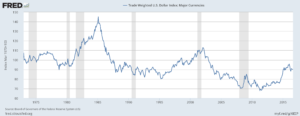Budget deficits, subzero interest rates and money printing are solutions to combat an economic collapse, says a new Federal Reserve paper.
If the United States economy enters another disastrous recession, similar to what happened in 2008 and 2009, then the Federal Reserve may have to ignite a $4 trillion quantitative easing initiatives. This is the suggestion made in a brand new Fed staff working paper, authored by economist David Reifschneider.
The paper makes the case that historically low interest rates, the near $5 trillion balance sheet and the lackluster U.S. economic recovery could actually hinder the central bank’s use of conventional monetary policy tools in the event of another recession. In other words, the Fed would have a difficult time employing traditional tools to juice the national economy.
Here is what the Fed paper states:
“In the simulations. QE and forward guidance take 10yr yields down 225-300 bps depending on the starting point for fed funds and whether you do $2 trillion or $4 trillion for QE. But that is not going to work very well if by design fed funds and 10yr yields can’t go below zero. And if expected rates are already low then forward guidance does not have much room. Fed official will gave to keep a straight face while saying they we will keep rates at zero … forever.
“What makes it work is that QE and committing to low rates for longer gets the long rate down quickly and this compensates for the inability to take short rates down as far as you would want. In the unconstrained model, the maximum drop in short rates is almost 9 percentage points, almost twice as much as in the constrained model, but the QE/forward guidance lower takes (and keeps) long rates 75bps lower than when the Fed takes rates to zero and stops. When the Fed is starting from 3% fed funds, the combo can almost entirely offset the zero constraint, but only if the full $4 trillion QE is brought to bear. Starting from 2%, QE of $2 trillion is not enough to get long rates down far or fast enough to offset the shock.”
Should the U.S. central bank launch another round of QE worth $4 trillion then it would more than double today’s balance sheet.
The ultimate conclusion that the paper makes is that the Fed could not withstand a significant “economic shock.” Simply put: if a recession were to happen today or next year then the current armory the Fed maintains would not be enough to fend off an economic downturn.
In the end, according to the Fed working paper, nothing short of $4 trillion would be enough to stabilize the U.S. economy. This is frightening for the greenback, pensioners, average investors and the American people in general.
The U.S. will soon face an inflation tsunami from the last rounds of QE and the current money-printing schemes. If the Fed were to actually unleash another QE tidal wave then that would lead to a full-blown dollar collapse.
Just take a look at the state of the U.S. dollar over the last 40 years:
 It shall be interesting to see what Fed Chair Janet Yellen says during the central bank’s annual summer retreat in Wyoming this week.
It shall be interesting to see what Fed Chair Janet Yellen says during the central bank’s annual summer retreat in Wyoming this week.
Leave a Comment